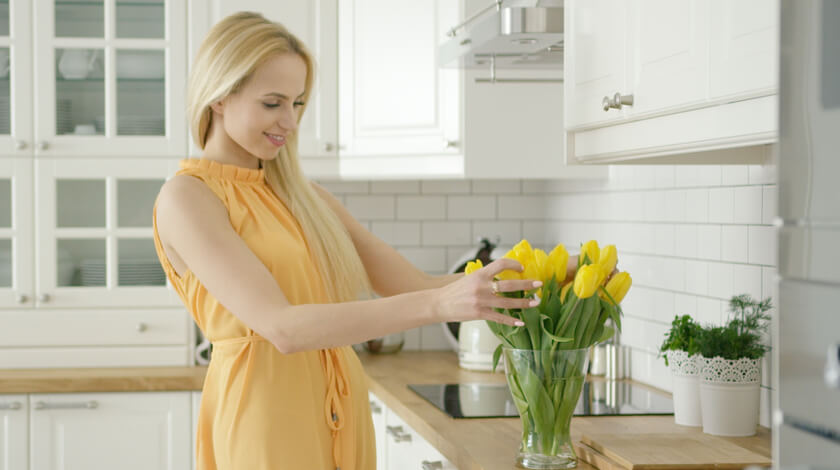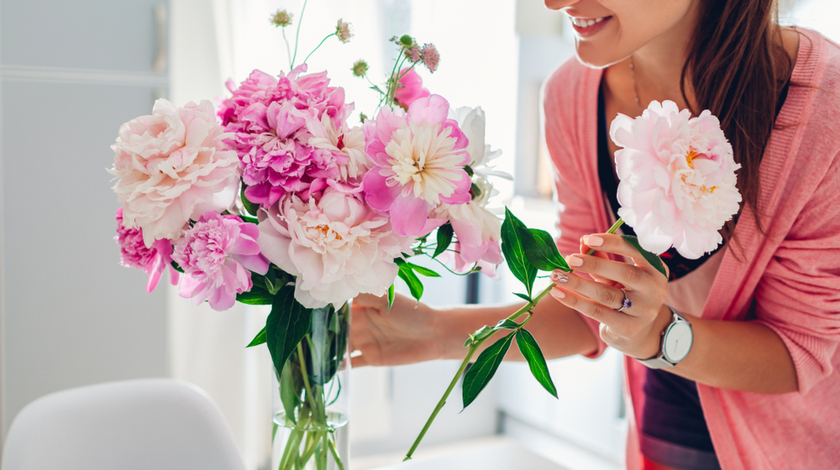

Simple Tips to Make the Most out of Your Hand Cut Flowers
Firstly, I think an introduction of some sort is probably in order as hopefully I will become your online tutor in the wizardry and magic of the floristry trade over the coming months. I’m Ben and I’m the newest member of the Flower Shops Network team. I’ve been tasked with creating some interesting “How to…” tutorials for our online magazine and today will be my first attempt, so here goes….
Back to Basics
Everyone loves being on the receiving end of a beautiful bunch of flowers, I don’t care about age, gender or religion, everyone loves flowers! Except for maybe those poor, unfortunate hay fever sufferers, I feel for you.
So you’ve just had a well-deserved bouquet of beautiful, fresh blooms dropped off at your home, office or secret retreat, now what? I think most people know to put them in a vase of water and for many people that’s as far as it goes, and that’s fine, your flowers won’t shrivel into nothing sitting in water and you should get a good few days glorious enjoyment out of them.
But remember why I’m here….To let you in on a few trade secrets to ensure you get the most out of your stunning display, to help your flowers shine long after the sun goes down.
Simple but effective

1. First thing first is your vase. Not everybody has a vase cupboard at home! I’m guessing the majority only have a couple at most and that’s normal, but I can help you get the most out of them.
Try to ensure the vase is big enough for your display, overcrowding can lead to premature degradation of your flowers and we don’t want that. If your bouquet is too big, divide into 2 or even 3 displays using vases, bottles or any other receptacle (I once had a small, handpicked posy in an old Marmite jar for weeks!) and place them throughout the room or house to really brighten up the place.
2. Make sure your vase is clean! Sounds simple enough but so many assume as its “just flowers” cleanliness isn’t an issue….. Wrong! Just because flowers grow in mud doesn’t make them dirty. Their precious root systems act as filters when feeding, ensuring no nasty bugs or microorganisms enter the plants. When removed from the roots there is only the stem left for the uptake of water and its super easy for germs to get in and rot the stem and eventually the flower.
3. If your vase is clean, so should your water be. (Sounds like Yoda said that, sorry!) Water in the UK is very different depending on geographical location, but whether hard or soft water, just make sure it’s clean water! I’m not suggesting you bathe your floral beauties in Perrier or Evian, just tap water is fine, but transportation of water to plants should be done in a clean receptacle.
A little known florist’s secret is to place your cut flowers in lukewarm water, not boiling or even hot, just a little warm. Warm water molecules move faster than cold water molecules and as the end result is getting water to the head of the flower, the faster the better really. This rule applies to most flowers but not all, flowers grown from a bulb such as; Tulips, Hyacinths and Iris’ should only be placed in cold water as they have much softer stems.
4. Preservatives are designed to feed your flowers even without a root system and are therefore a solid suggestion, many florists these days will include a sachet of salts or gel for you to add to water to prolong the longevity of your flowers. These typically include: acidifiers which adjust the pH of the water, carbohydrates for flower cell metabolism and biocides which combat bacteria and keep your flowers healthy.
There are plenty of old wives tales out there on the best way to keep flowers looking gorgeous for longer, and as with many such tales, they’re based around an element of truth. Good examples of old wives tales that work are a spoonful of sugar or an old copper penny. If you put them in the vase with water both will benefit your flowers because sugar is a carb and copper reacts with water releasing a weak acid. If you want to make your own preservatives at home here is a simple life hack to help you out.
A great recipe I’ve used before is:
1 teaspoon sugar
1 ½ teaspoon lemon or lime juice
½ teaspoon bleach
Mixed with a litre of lukewarm water
The idea of putting flowers in bleach is a shocker to most, me included! But it acts as an anti-fungal/bacterial killing most germs, the sugar acts as nutrients and the citric acid regulates the water, all in all keeping your flowers happy and looking their best for longer.
Arrangement time

Now that our vase and life preserving fluids are prepared, it’s time to tackle the delicate arrangement of your beautiful flowers. Here are a few tips from our artisanal local florists:
1. As stated above, never overcrowd your display.
2. Aesthetics are crucial when creating floral displays and the golden rule is that your flowers should never be more than one and a half times the height of your container.
3. Aesthetics again! Your arrangement should try to appear uniform, consistent and if possible symmetrical. Group flowers of similar size or colour together.
4. If possible give your flowers some support by placing each flower on an angle in the vase and build a lattice of stems that can be woven together for support. Once you have your web or grid of stems you can add your last central flower and stand it up straight in the middle thanks to support from your lattice.
Top-Tip: The last central flower should be the only flower not placed on an angle!
Show some support

Ok! Now we’re getting somewhere. All that’s left for me to mention is the continued care and well-being of your now perfectly presented flowers. Most of these next few tips are common sense, but as we care about your gorgeous bouquets giving you as much pleasure as possible, I’ll state the obvious anyway!
1. Always keep an eye on the water levels in your vase and keep topped up so it never runs dry.
2. Always discard any wilted or dead flowers. It may be painful to break up the party but it’s for the benefit of the bunch.
3. Flowers that go limp without wilting are probably struggling to get a drink; you can rescue these thirsty ladies by re-cutting the bottom of the stalk. Take some clean scissors and carefully cut off about an inch, no more, from the bottom of the stalk and if you make the cut on the diagonal, your flowers will say thank you!
4. Placement is everything. Don’t spend all this time prepping and lovingly doing everything you can to ensure the lifespan of your fragrant display, only to place the vase in direct sunlight, or worse in the dark or possibly in a drafty spot, or right in everyone’s way where they will be constantly battered by passers-by! Flowers are like Goldilocks, they want things to be just right, so take a little time and pick the best spot for displaying your beautiful flowers.
If you’re still here and reading, well done for sticking it out! I really hope you found something of use in this, the first of my “How to…” tutorials and hopefully you’ll stick around until next time when I’ll be back with another snack sized and informative lesson that revolves around the flower industry.
I’ve just been informed that I may be let loose with a video camera for my future tutorials….
Watch out, next stop Hollywood!
Until then, Flower Shops Network!
